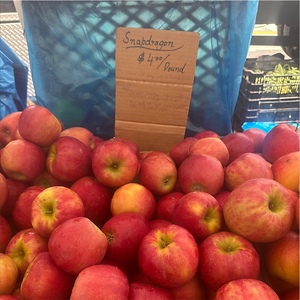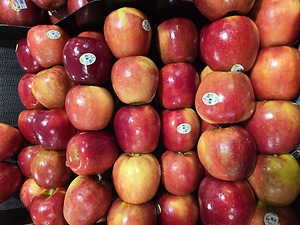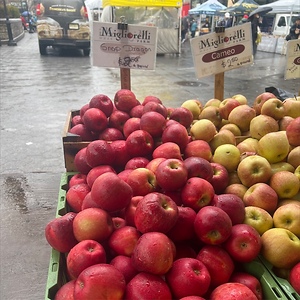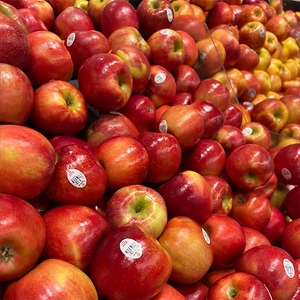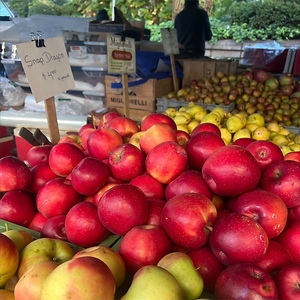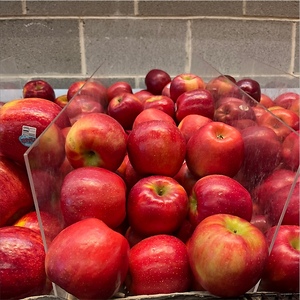

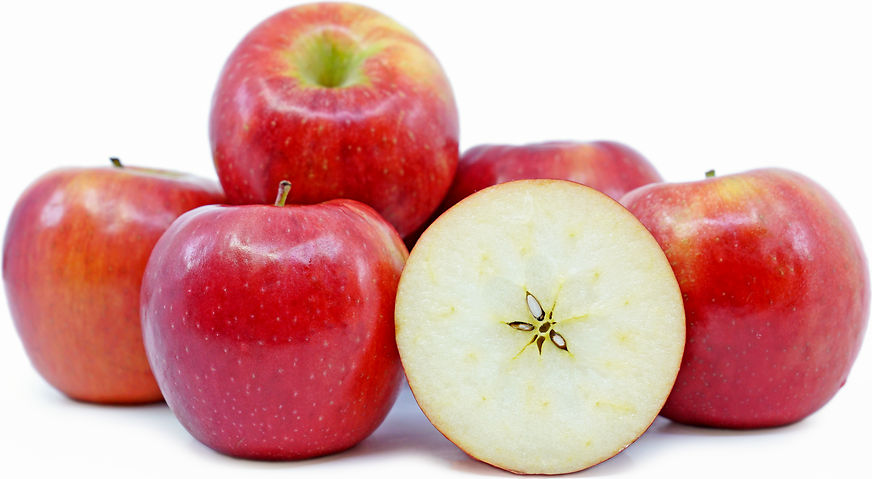
SnapDragon Apples
Estimated Inventory, lb : 0
Description/Taste
SnapDragon apples are medium to large fruits with a round to conical, slightly tapered shape. The skin is smooth, glossy, lightly ribbed, and firm with a yellow base hue, covered in a dark red blush and prominent tan lenticels. Underneath the surface, the white to ivory flesh is crisp, coarse, and aqueous, encasing a small and fibrous, central core filled with brown-black seeds. SnapDragon apples have a very sweet, subtly tart flavor with vanilla, melon, and spice-filled undertones.
Seasons/Availability
SnapDragon apples are available in the fall through early winter.
Current Facts
SnapDragon apples, botanically classified as Malus domestica, are a relatively new, sweet apple variety belonging to the Rosaceae family. The crisp fruit was developed by Cornell University’s apple breeding program, one of the oldest programs in the United States, and the apple was created to exhibit improved storage qualities, flavor, and disease resistance. SnapDragon apples were bred from the popular honeycrisp apple and are favored by consumers for their sweet, crisp, and juicy flesh. The variety was also one of the first apples from the Cornell University breeding program to be released under an exclusive licensing agreement with Crunch Time Apple Growers, formerly known as the New York Apple Growers. This licensing agreement allowed the university to retain intellectual property rights to their research and charge a limited royalty fee to farmers who grow the cultivar.
Nutritional Value
SnapDragon apples are a good source of fiber, which helps regulate digestion and are high in vitamin C, an antioxidant that strengthens the immune system, boosts collagen production, and reduces inflammation. The apples also contain lower amounts of calcium, vitamins E and K, phosphorus, and potassium.
Applications
SnapDragon apples are best suited for raw applications as their juicy flesh is showcased when consumed straight, out-of-hand. The variety is heavily marketed as a children’s snack due to its sweet flavor, and the flesh can be sliced and served with cheese, peanut butter, or caramel. SnapDragon apples can also be chopped and mixed into green and fruit salads, sliced and stirred into overnight oats, oatmeal, or porridge, or blended into juices and smoothies. In addition to fresh applications, SnapDragon apples can be simmered into jams, relishes, and sauces, cooked and served over roasted meats, or baked into bread, pies, tarts, cakes, and pies. SnapDragon apples pair well with nuts such as walnuts, almonds, pecans, and pistachios, cheeses such as cheddar, fontina, feta, and goat, thinly sliced meats including bacon and prosciutto, cranberry, citrus, butterscotch, honey, cinnamon, raisins, and broccoli. Whole SnapDragon apples have a long shelf life and can be stored 4 to 8 weeks when unwashed in the refrigerator's crisper drawer.
Ethnic/Cultural Info
SnapDragon apples were marketed to consumers in 2018 through a launch party in New York City through Crunch Time Apple Growers. The weekend event featured an evening gathering to mark the beginning of the SnapDragon apple season and to highlight the variety’s strengths. Apple growers, media correspondents, and celebrities attended the celebration, and chefs used the sweet fruit as the main flavoring in cocktails, appetizers, and small dishes to showcase the fruit’s versatility. During the launch, SnapDragon apples were also featured in Times Square to promote the local, New York variety. Participants had the opportunity to try a SnapDragon apple and give feedback to the marketing team about what they thought of the new variety, and they were also entered into raffles to win prizes such as a new bike. It was reported that even the famous Times Square performer, known as the Naked Cowboy, joined the event and sang a jingle dedicated to the SnapDragon apple.
Geography/History
SnapDragon apples were developed in the early 21st century through Cornell University, in partnership with Crunch Time Apple Growers, at the New York State Agricultural Experiment Station. The variety took over a decade to create, trial, and research, and the apples were primarily developed by breeder Susan Brown. SnapDragon trees were planted in select orchards in 2011, and their official name was released in 2013 at a field day event at the experiment station. Today SnapDragon apples are exclusively grown in New York state through licensed farmers and can be found at farmer’s markets and specialty grocers.
Recipe Ideas
Recipes that include SnapDragon Apples. One



